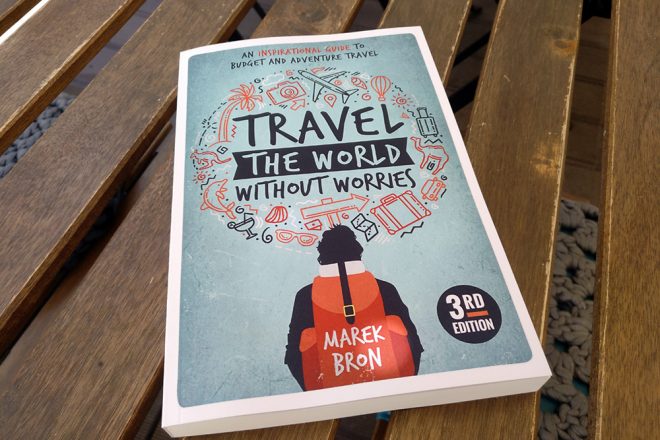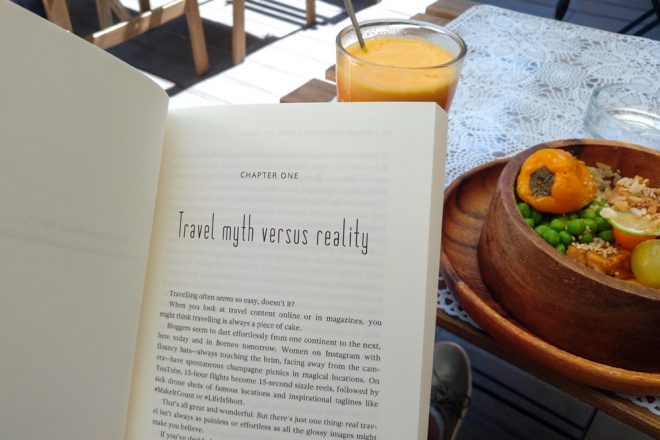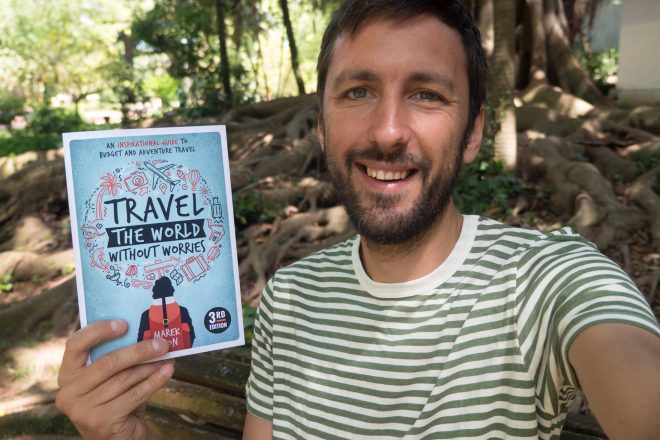To mark the release of the new 3rd edition of my book Travel the World Without Worries, I’ll be sharing some lessons I learned during the writing process.
Six years ago I set out to write a full-length book with zero author experience. Now, a mere two editions later, I feel like I finally created the ultimate version of it!
The goal of the book was simple: to inspire you to go on a big travel adventure — and to arm you with all the tools and tips you need to make the absolute most of it.
The book turned out to be the most gratifying project I’ve done, as I keep getting emails and DMs from people who felt inspired, motivated, or simply more assured before setting off to parts unknown.
This year I updated it with new chapters, new resources, and many more tips from my past 7 years of continuous and on-and-off travelling.

1. Make it relatable
When I first started backpacking back in 2012, I kind of came rumbling and tumbling into the world of travelling. I didn’t have much of a clue!
Later, realizing how much I’d learned about the travelling ways, I thought it’d be fun to write a small practical guide to publish on Amazon. So, under a bamboo parasol on Gili Trawangan in Indonesia, I started tapping away.
But when I looked at my first outlines, I quickly realized something important: I wasn’t writing a book, but a glorified to-do list.
Sure, I was collecting some really great travel tips. But I kind of came barging into every topic from a helicopter-view, dropping bullet-point tips from above. Rarely did I really land anywhere to give a more complete or personal perspective.
I knew the book couldn’t just be an information dump. A reader also wants to relate to the subject matter… and to you.
And that meant I had to slow down.
I soon got an editor, who urged me to share more mishaps and triumphs from my own travels. When I did, my writing became much more fun to read — and more fun to write, too!
It’s certainly useful to know that, say, you should always bring multiple bank- or credit cards on a trip and stash them in different places. But it’s even better if I tell you about the time I totally freaked out when I found myself in a cold mountain town in Bolivia with all my cards lost or stolen — and the utter relief I felt when I could still get some cash abroad without a bank card.
By adding personal stories, the book truly began reflecting the joys, fears, frustrations, revelations, and achievements you can feel when travelling in new and unfamiliar places.
2. Research and ask your audience
I started the book’s outline based on my own travel experiences, but I soon learned about the value of researching your audience’s pain points and goals.
I collected questions, comments, and DMs from my blog and invited subscribers to my mailing list to ask me about any issues they were facing. I also used Reddit to make sure I covered everything, making note of commonly asked questions in several travel-related subreddits. This helped a ton in refining my outline and adding more elements beyond my own immediate experiences.
Besides the book’s contents, I also asked my audience to help choose the cover design for the new third edition. I had four designs created, but I couldn’t decide which one to choose. When I asked you to vote, the response was huge!
Cover 4 had by far the most votes (59), followed by cover 1 (38) and cover 2 (19 votes). Cover 3 only got 6 votes, though I expected it not to do as well.
Running this poll was of tremendous help in choosing the winner. I think a lot of travellers can relate to the winning cover, which depicts all the thoughts that might swirl through your mind before setting off to parts unknown.
3. The introduction is the hardest part
When I submitted my first draft to my editor, I already knew what he was going to say:
“Marek… do you realize you wrote three different introductions?”.
I just didn’t know how to start the book! And so I had in effect written three introductory chapters, and none of them really worked.
It eventually got easier for me to write the book’s core chapters, but I continued to struggle with the introduction until the very end.
It’s probably because an introduction has to do so many things at once: it has to hook the reader, define what the book is about, explain what you might learn from it, and introduce the author. The introduction also has to more or less ‘sell’ the book, as it’s usually these pages that people can read for free on platforms like Amazon.
So that’s a lot of pressure on just one chapter!
What probably didn’t help with the first edition in 2013 was that I was still a bit insecure about my position as a ‘travel expert’. I had not yet travelled to certain parts of the world and had some hangups about this. I think I overcompensated at first by pitching the book as the best thing since sliced mayo. When I felt more comfortable about the insight I had to share, it was easier to find the right angle and explain in a relatable way what the book is about and who it is for.
What I learned is that introductions are hard. It wasn’t until the third edition that I was truly happy with it! If I ever write a new book, I’d definitely want to get the introduction right before writing anything else.

4. You definitely need an editor
I set out writing a whole book without ever having done such a thing before… and I set off to do it on my own.
That meant that I got quickly lost in the details. The deeper I got into the project, the harder it was to see what worked or didn’t work.
Eventually, I decided to get an editor (despite the added expense) and this made a stunning difference. Whenever I’d get back development notes, it felt like I’d just grabbed the yellow star in Mario Kart. Suddenly I’d plough ahead, go twice as fast and bump every obstacle out of the way… at least for a while.
A good editor will make it easier for you to see the logical structure, to cut unnecessary sections, and to gain more confidence that things really do work.
Curious about the book? You can read the first chapter for free here!
P.S. If you’re wondering, I used Amazon KDP to publish the e-book to Amazon Kindle. I also used KDP (formerly known as Createspace) to create the paperback version. Unlike traditional publishing, the book gets printed on demand and more of the royalties go to the author, which can make this an interesting way to sell your book to an existing audience.
I used Draft2Digital.com to publish it to other platforms like Kobo and Apple iBooks. Finally, I sell the ebook version myself through this blog, using GetDPD.com to handle payments and delivery.
Some links may be affiliate links, meaning I may earn commission from products or services I recommend. For more, see site policies.






I am buying the book! Thanks for this. I am glad, there is someone like you!
Thanks Matouš! 😀